| ..... |

Smithsonian Folkways Series
Volume 11 to Volume 20
Covers, RealAudio sound files,
and purchase links via amazon.com
|
| |
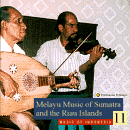
Volume 11
Melayu Music
Of Sumatra And
The Riau Islands
Purchase
info
and RealAudio samples |
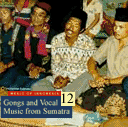
Volume 12
Gongs And
Vocal Music
From Sumatra
Purchase
info
and RealAudio samples |
| |
Volume 11
With their Arabic vocal style, melody, lute instrumentation,
and frame-drum rhythm, pieces in the zapin genre could be marvelous
examples of Middle Eastern music rather than Melayu (or Malay) pieces. Islamic
elements recede in theatrical musical forms mak yong and mendu,
where interlocking metallophone figures and percussion meet wafting lead
and unison vocals. The disc ends with three appealing performances in the
ebullient ronggeng genre, which has a reputation for flirtation that
gets out of hand as the female dancers flick sparks at male audience members.
Ronggeng also benefits from a tug of war between local and European elements
as the singer pops between minor- and major-key intonation.
Volume 12
Melodic gong ensembles and male singing with percussion are found
throughout Sumatra. Two of each are heard here: West Sumatran talempong
(in two contrasting forms); kulintang from Lampung, at the southern
end of the island; the choral didong songs of the Gayo in Aceh, and
salawat dulang, competitive duet singing from West Sumatra that suprisingly
uses popular songs as a vehicle for texts on points of Islamic doctrine. |
| |
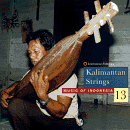
Volume 13
Kalimantan
Strings
Purchase
info
and RealAudio samples |
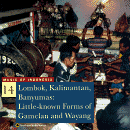
Volume 14
Lombok, Kalimantan,
Banyumas: Little-known
Forms of Gamelan
and Wayang
Purchase
info
and RealAudio samples |
| |
Volume 13
I expected the songs of the Dayak highlanders of Borneo to be
jagged and intense, not delicate and reflective, though there is a high-altitude
mountain-music quality to the material. "Three Dance Tunes" is
a string-plucking medley for scallop-fretted sape Kayan lute which
joins with bluesy female vocals on "Lupaak Avun" (Waves of Fog),
a tune once used to ward off thunderstorm. More in the hoedown mood is "Karungut
Saritan Nampui Kampang" with lute, rabap fiddles, and a scale-straddling
vocal by Syaer Sua.
Three songs by Muslim Kutai musicians trade the oriental shadings of
the rest of the disc for a sound with probable roots in the Middle East,
while two pieces by the Ot Danum people throw in a tapped-out glass bottle
backbeat. By far the loveliest material is a trio of songs from East Kalimantan
showcasing sampeq lute duets that call to mind intertwined mandolins
from a parallel-universe Appalachia. Yee ha!
Volume 14
Jemblung, an endangered all-vocal gamelan genre, features
three males who mimic the dings and dongs of metallophones while the pesinden
female vocalist bravely sings lead as gracefully as if she were backed by
the finest Javanese orchestra. Maintaining her dignity isn't easy. The trio
pantomimes hitting mallet instruments (along with one another) or grimaces
and gyrates in imitation of the shimmering bronze keys. To make matters
worse, they interject low jokes such as "Your gong's out of tune, dummy."
Despite the burlesque of high culture, the vocal interplay remains as
engaging as the most serious court gamelan recording, and the pesinden vocal
carries me away with her otherworldly yearning. Also included is a neck-snapping,
real-bronze-instrument 31:05 overture to a wayang shadow puppet play
by the Kresna Group from southern Borneo. |
| |
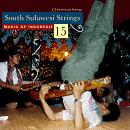
Volume 15
South Sulawesi
Strings
Purchase
info
and RealAudio samples
|
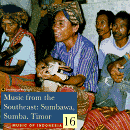
Volume 16
Music from the
Southeast: Sumbawa,
Sumba, Timor
Purchase
info
and RealAudio samples |
| |
Volume 15
This highly listenable disc includes several selections by the
Bugis people, whose pirates were so feared by European traders when Indonesia
was known as the Spice Islands that bratty children were threatened with
the boogie man. A tightly knit trio of kacapi two-stringed lute players
weave repetitive figures around one another on the opening cut followed
by a soulful narrative song that's a kind of local variation of our grasshopper
and ant fable. There are also a couple of brooding violin pieces, songs
with a Popeye lead vocal cut from the same mold as Tuvan singing styles,
plus a three-song kacapi medley by the Toraja people--whose spaceship-looking
buildings are etched in my memory from the PBS Ring of Fire television
series.
Volume 16
This CD, in conjunction with Volume 8 and Volume 9, offers the
first recorded survey of one of the least known and most musically surprising
regions of Indonesia, the southeastern islands. Each of the three featured
islands presents a unique sound, from voice and violin to funerary gong
ensembles, to string bands of homemade guitars and violins. Many of the
15 tracks reveal foreign influences, both from colonization and American
exposure. The inclusion of tracks from Timor is particularly welcome, as
it helps put a face (and a voice) on an island that featured prominently
in the news of 1999. |
| |
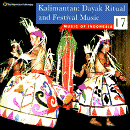
Volume 17
Kalimantan:
Dayak Ritual and
Festival Music
Purchase
info
and RealAudio samples |
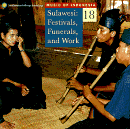
Volume 18
Sulawesi:
Festivals, Funerals,
and Work
Purchase
info
and RealAudio samples |
| |
Volume 17
This ambitious album presents music from seven Dayak groups of
Kalimantan (Indonesian Borneo). Many selections are devoted to gong ensemble
unlike either the large gamelan of Java and Bali or the interlocking gong
ensembles of the southeastern region. Contrasting styles of choral singing
are heard, as well as four rhythmically bewildering pieces for an ensemble
of bamboo tubes struck together. The album closes with an unusual twenty-three
minute overview of the music from a three-day curing ritual among
the Ot Danum of the Melawi River region in West Kalimantan.
Volume 18
The celebrated Makasar genre pakarena features energetic
drumming in sharp contrast to the slow, graceful movements of female dancers.
Basing is the funeral music of the Kajang, performed by two female
singers and two long flutes, or by the flutes alone. Choral singing in very
different styles is heard from the Torja, from Uma-speakers of the mountainous
Pipikoro region in Central Sulawesi, and in communal work songs of Minahasa.
Also included is gong music for Mongondow weddings and spirited choral maengket
singing from Minahasa with drums in celebration of the harvest. |
| |
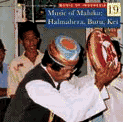
Volume 19
Music of Maluku:
Halmahera, Bura, Kei
Purchase
info
and RealAudio samples |
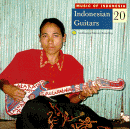
Volume 20
Indonesian
Guitars
Purchase
info
and RealAudio samples |
| |
Volume 19
The title points to little visited much less musically documented
islands in the province just west of Indonesian New Guinea (aka Irian Jaya).
A smooth lute and fiddle piece leads the way, and is joined by a pleasurable
drumming song, children's chorus, metallophones composition, a delightful
flute and gong song entry from Kei, and a lusty trio of Arabic-language
devotional dabus recordings from Halmahera featuring male singers backed
by frame drums and tambourine. I can't claim every note of this disc goes
down like syrup, but it's one of the happier blends between the genteel
and exotic in the entire Indonesia series.
Volume 20
Disc opener "Kemayoran," compliments of the Mandar
people' Grup Bamba Puang from South Sulawesi leans on an American-style
folksy guitar to set a lovely throb until the entry of a hackle-raising
singer that may suggest immediate surrender. But stick with this intriguing
disc and you'll live through a wonderful oud-influenced piece by blind guitarist
Sahilin from Palembang, South Sumatra, as well as the truly crazy ditty
"Sungguh Terpaksa." The latter spotlights Bugis wildman La Podding
pecking at an amplified kacapi lute in service of a parody of big city big
star Rhoma Irama, featured in all his excessive Indopop dangdut glory
on Music of Indonesia 3, Indonesian Popular Music. The aurally adventurous
are invited to test and tickle themselves with Guitars. As always,
profuse and entertaining liner notes guide the way.
Thanks to Smithsonian Folkways labels for the descriptions
of volumes 7, 10, 12, 16, 17, and 18. All other descriptions are adapted
from reviews by Bob Tarte that originally appeared in The Beat magazine
and are Copyright 2000. The full text of these reviews can be accessed via
the Asia index page. |
| |
Music of Indonesia, Introduction
Music of Indonesia, Volumes 1-10
Music of Indonesia, Volumes 11-20
Technobeat Central
|